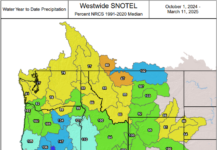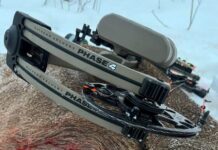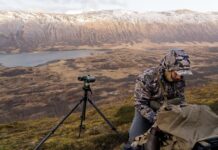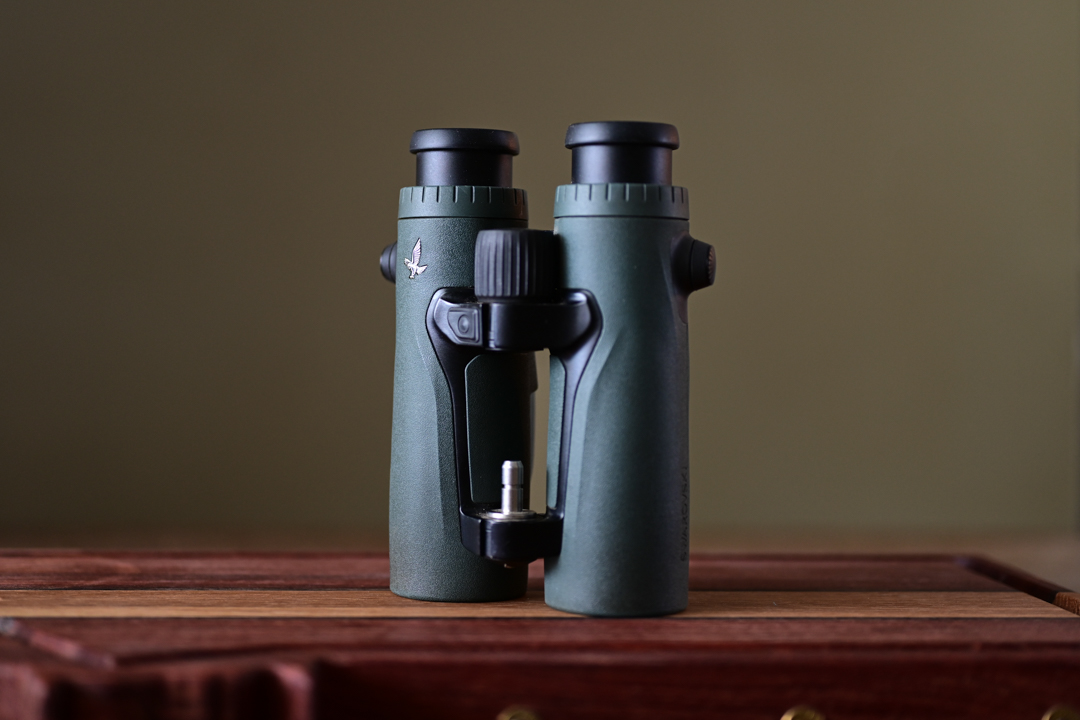
My pickup rolled to a stop on a hairpin corner of the road in the Sapphire Mountains of Western Montana. I had just set up a 10-inch steel target on the opposing ridge, accessed by the same winding road. I shuttled my shooting gear to a flat location on the hill and finally nestled a rear bag under my rifle stock. A little forward load into the bipod and a check of the scope level gave me a clean sight picture of the spray-painted steel target.
Swarovski EL Range TA
My eye left the riflescope and reached over for Swarovski’s newest range-finding binocular, the EL Range TA. The 10X magnification brought the target into sharp focus, even through the sunny day’s mirage. I held the ranging button and released it as the reticle floated over the target.
The display lit up with the range immediately: 726 yards.
A second later, the display gave me an elevation correction: 15.2 MOA.
I decided against a wind hold, given the very slight breeze was coming from directly behind me at my shooting position. I dialed 15.25 MOA on the turret. I again went through the steps to build a prone shooting position. I squeezed the rear bag and brought the crosshair to the center of the target. At the natural pauses in my breathing, I applied pressure to the trigger and followed through the recoil. Boom … Ding! That satisfying sound of struck steel found its way back to me.
A glance through the spotting scope confirmed my elevation correction was spot-on with the bullet impact cutting the orange painted water line through the middle of the target, albeit to the right side a couple of inches.

The Binocular
There was a time that long shots like this took a slew of equipment to figure out. First you needed a rangefinder, if you could find one that could range that far. Then you needed a weather meter to give you atmospheric data, and finally, you needed a ballistic computer to interpret the data and give you a correction.
Ballistic computing range finding binoculars do all of these functions instantaneously…and do it well. After I started hunting with a ballistic range finding binocular a few seasons ago, I found the convenience, especially when rifle hunting, hard to live without.
Swarovski Optik recognized the multi-use convenience of a rangefinding binocular when they released their original EL Range series of binoculars. Hunters found the combination of a high quality binocular and reliable rangefinder pretty convenient too.
However, Swarovski didn’t rest on their laurels and threw some capable technology at the upgraded “TA” version of the EL Range.
First, they updated the optics, including “HD” fluorite glass in the design as well as field flattened “Swarovision” eyepiece construction.
Second, they installed onboard atmospheric measuring instruments that can provide real-time atmospheric information, as well as an inclinometer for shooting angle data, and a compass for the Tracking Assistant features.

My EL Range TA test unit included an Outdoorsman’s binocular adapter stud installed on the interior of the forward bridge. Adapting any binocular to a tripod is extremely helpful for long glassing sessions but even more important for range-finding binoculars. That added stability makes getting reliable ranges of smaller targets at long ranges a breeze. The unit is supplied power from a single CR2 battery stored in the focus knob.


The EL Range TA doesn’t have the normal binocular profile compared to the competing Zeiss RF. Swarovski maintained the under-barrel humps from the original EL Range to house electronics. The feel in-hand is pretty ergonmic, however, and the humps never interfered with my grip or use of the binocular. The humps did take up a lot more room in my medium FHF Gear binocular harness, though, and the added room in a bigger harness would have been appreciated. The added bulk does NOT translate to added weight, however, as measured weights on my scale showed the EL Range TA actually weighed nearly 1.5 ounces less than the more slender Zeiss RF.


Like the Zeiss RF, the Swarovski EL Range TA has a diopter adjustment on each barrel; one for the normal dioptric adjustment, and the other for the display screen focus. Unlike the Zeiss, the Swarovski had a push/pull locking system for the adjustments, which provides peace of mind in the field.
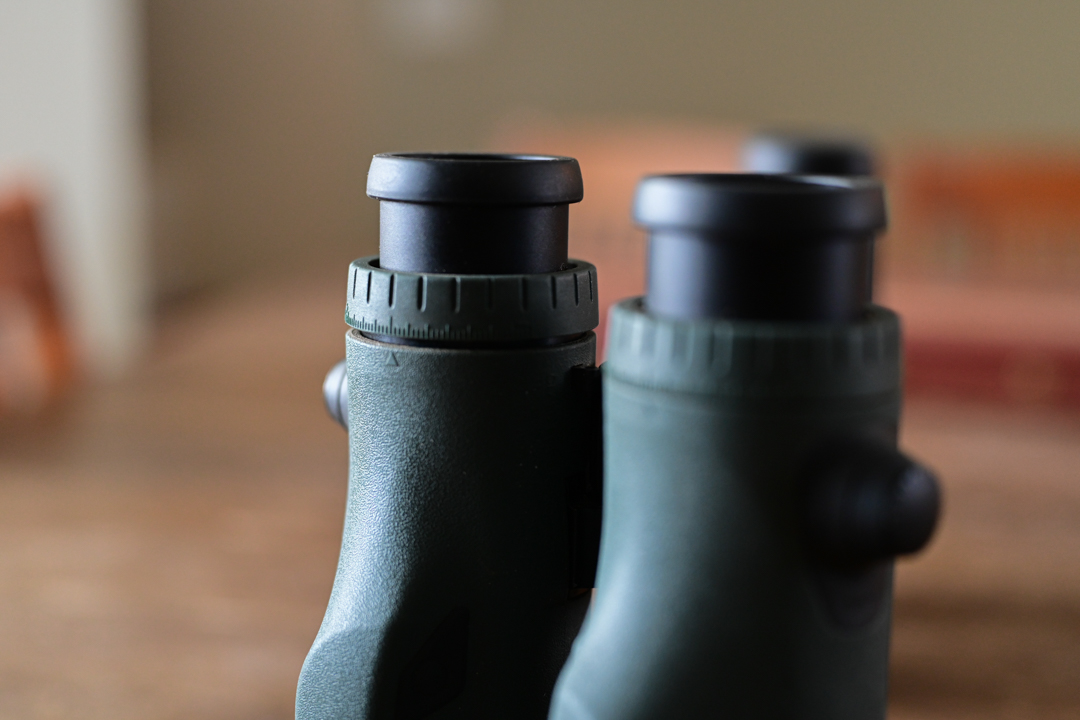
Performance Optics
The optical performance of the EL Range TA is, in a word, excellent. The field of view is quite wide at 359 feet/1000 yards. The EL Range TA has that typical Swarovski view:
- Deep apparent depth of focus with pin sharp resolution to very near the edge.
- Very little field curvature.
- Extremely mild pincushion distortion with comfortable panning.
- A bright, clean image with a warm color bias.
- Chromatic Aberration was negligible in the center of the field and mild at the edge.
The optical performance of the EL Range TA is very reminiscent of the excellent Swarovski EL Swarovision models.
Build quality was again typical of Swarovski. The rubber armor was thick, textured, and comfortable. The removable eyecups were nicely sized and robust in construction. The center hinges were smooth and held inter-pupillary distance firmly. The accessories provided were in Swarovski’s Field Pro system, including optional strap attachment methods, removable hinged objective covers, a quality neckstrap, and substantial ocular covers.
The Rangefinder and Ballistic Computer
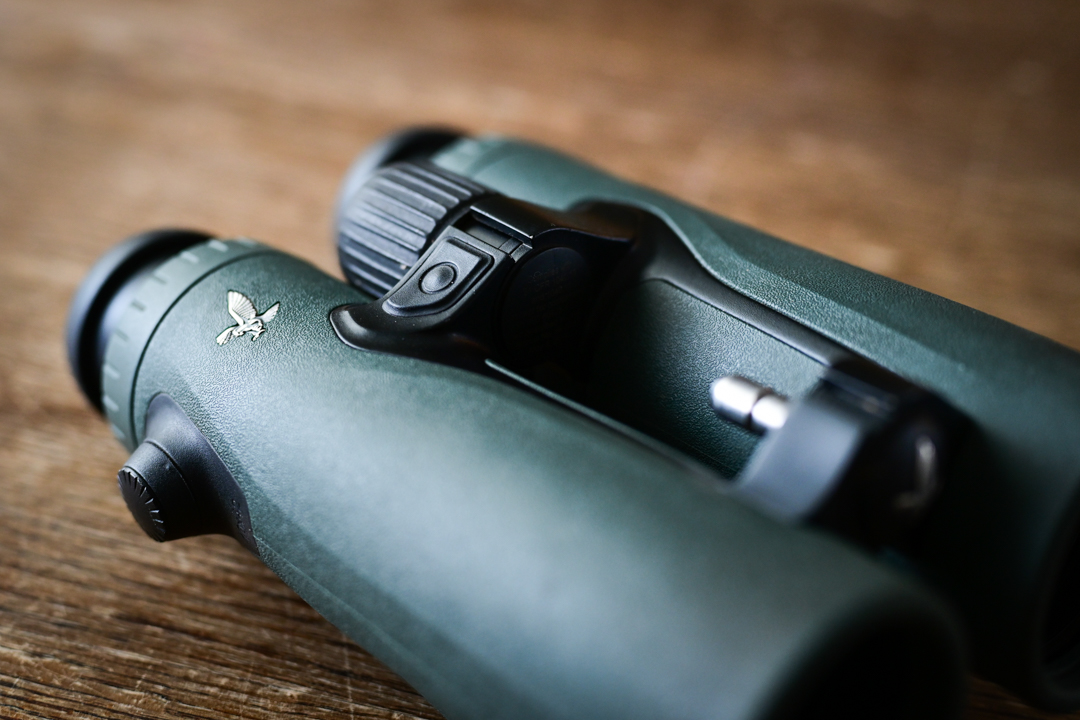
The listed specs for the EL Range TA’s rangefinder are:
- 10 – 2200 yards
- +/- 1-yard accuracy
- Less than or equal to 0.5 seconds measuring time
- Angular measurement plus and minus 99 degrees
- 2000 measurement life cycle
The full list of specs is available here.
The measurement button is on the right side of the rear bridge. The Mode button is on the underside of the barrel next to an indicator light. There is no left-handed model. Ranges are displayed almost instantaneously, with the corresponding elevation correction displayed simultaneously on the second display line. The red display is adjustable for brightness, clean, and sharp, with the focus adjusted properly. I found the display better than the Zeiss RF display.
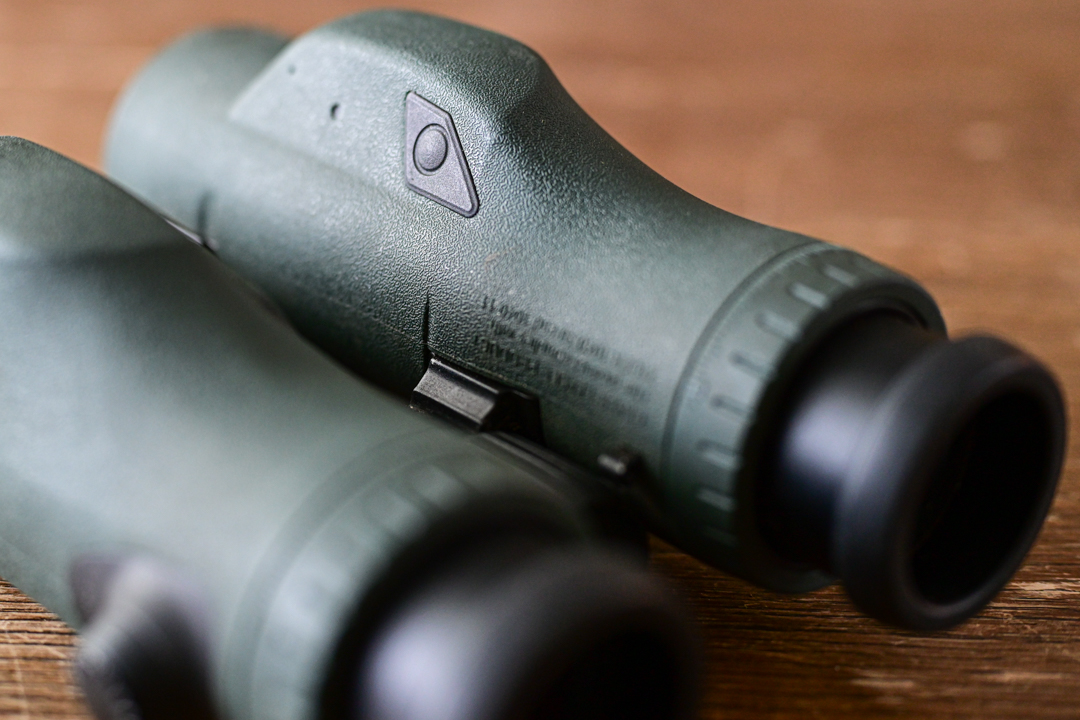
The range-finding performance was excellent. I could get ranges past 1400 yards on small trees and rocks under almost all circumstances. I could easily get ranges out near 2000 yards on large rock faces and reflective buildings in all but bright sunlight conditions. In very low light, the ranging performance was even better.
While archery hunters will appreciate the 10-yard minimum ranging distance and angle compensation abilities of the EL Range TA, rifle hunters will really make the most of the technology packed into the unit.
The EL Range TA can display several items on the second line, including holdover in MOA, MRAD, inches, or centimeters. Other options are atmospheric data, horizontal range, or angle in degrees. The hunter can choose drop information for one of three rifles loaded onto the device from their phone and switch to any of the three rifle profiles in the menu of the EL Range TA itself.
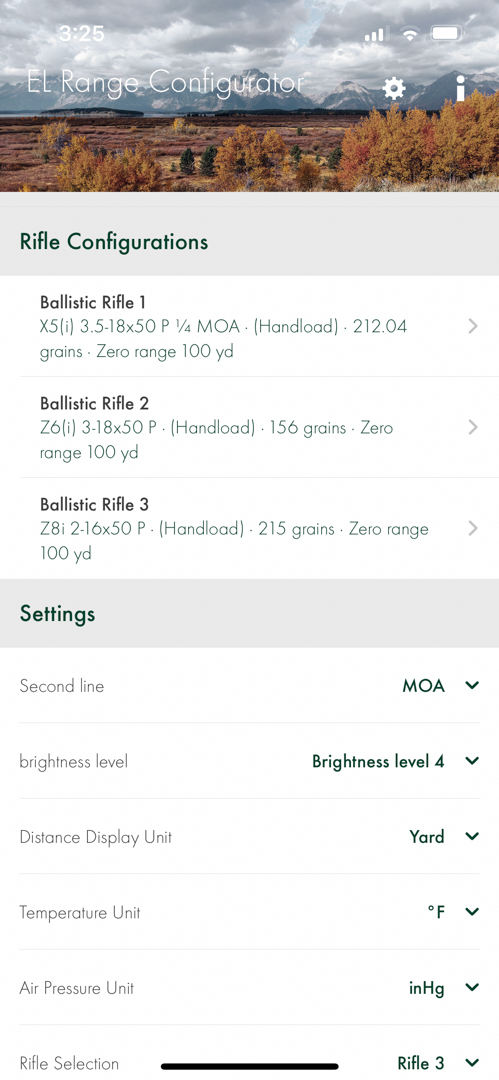
The EL Range app is available free for Apple and Android phones. The app connects from your device to the binocular via Bluetooth connection. I found the connection to be quick and reliable. The user puts both the phone and binocular into Bluetooth mode and selects the serial number of the desired EL Range that shows up available on the phone.
The user inputs basic ballistic data for three rifle profiles through the app. The user can select other settings like second line display options, brightness, and units as well. These settings are then synced to the EL Range TA, or the user can “restore” settings to the app from the EL Range TA.

The EL Range App has a good library of factory loads with the ballistic coefficients listed in the G1 model by default, but the user can edit this and manually enter a G7 value. The user can input custom load information using either G1 or G7 ballistic coefficients.
Only Swarovski scopes are available to select for each rifle profile, but it doesn’t affect the data provided, so users can use any scope they choose, as long as they select the compatible unit of correction.

I input the same ballistic information into the EL Range TA that I have in my Kestrel and Zeiss RF. The three devices would consistently give MOA corrections within .5 MOA of each other, with the EL Range TA and Zeiss RF usually being within .25 MOA of each other, even when ranging at steep inclines and declines.
I verified the drop information the EL Range TA provided out to 1300 yards. Once I had good ballistic coefficient and velocity information in the EL Range TA, it consistently provided good elevation correction data.
The EL Range TA does not provide wind data. Shooters will need to use another option or estimation to get wind correction information.
Tracking Assistant (TA)
Another feature included in the EL Range TA is the Tracking Assistant. This feature could be used in conjunction with the EL Range App or the binoculars outside of cell coverage. I played with this feature some but walked away underwhelmed. When connected to your phone, the app would provide general directions to one of the three last places you ranged, using bearing data from the binocular and the range distance. This only worked in cell coverage and only got you relatively close. The version of TA using the binocular alone outside cell service was quite cumbersome. It involves ranging back towards where you originally ranged from and would give you distance and left/right directions to get you close to the chosen ranged target.
Both Tracking Assistant options depended on periodically keeping the El Range’s compass calibrated through an awkward tilt/rotate process.
In practice, I greatly preferred just using my phone’s GPS app and the waypoint features to mark a spot to retrieve game. I found it quicker, more accurate, and more intuitive. Robby Denning did a quick video on the EL Range TA if you’d like a visual of it’s operation.
Conclusion
Swarovski raised the bar on the original EL Range with the newer EL Range with Tracking Assistant. While I found the Tracking Assistant functions a little lackluster, it didn’t take anything from the stunning optical and range-finding performance provided by the EL Range. From the optics to the electronics, Swarovski has brought the EL Range to the top level of performance range-finding binoculars. Hunters looking for the Swarovski viewing experience with reliable range finding and ballistic calculation can rest assured they are getting top-shelf performance. At a $3700 street price, the cost of admission is high, but many hunters will find the all-in-one combination of elite optics, rangefinding, and ballistic computation worth every penny. Head to the Swarovski website to order your pair.
Comment on this review or ask Matt questions here.
Continue reading our optics reviews here.





